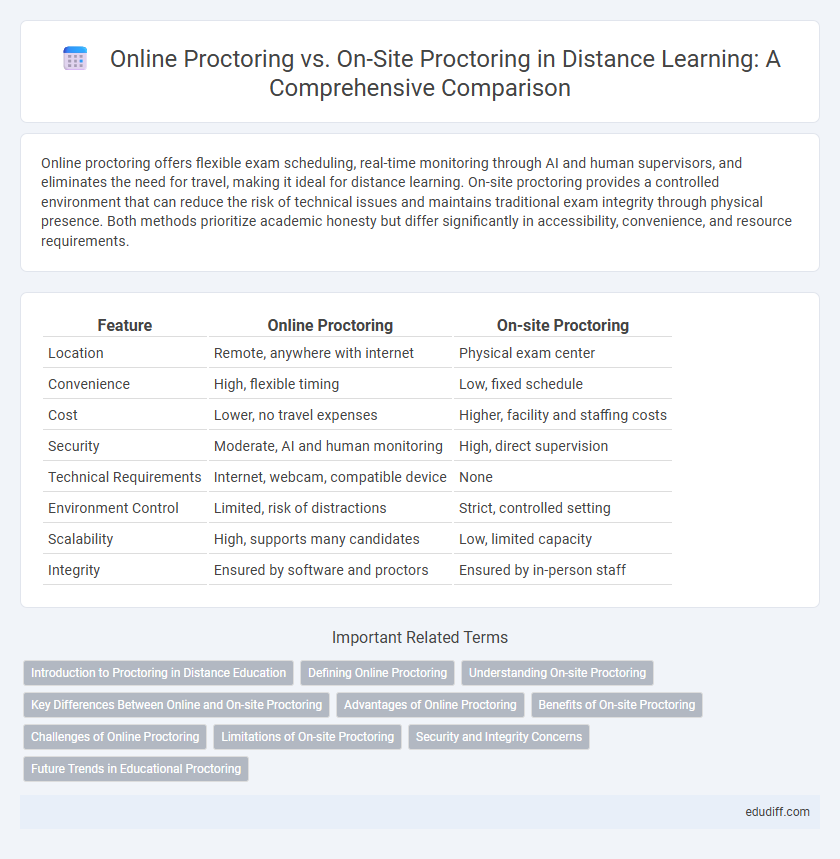Online proctoring offers flexible exam scheduling, real-time monitoring through AI and human supervisors, and eliminates the need for travel, making it ideal for distance learning. On-site proctoring provides a controlled environment that can reduce the risk of technical issues and maintains traditional exam integrity through physical presence. Both methods prioritize academic honesty but differ significantly in accessibility, convenience, and resource requirements.
Table of Comparison
| Feature | Online Proctoring | On-site Proctoring |
|---|---|---|
| Location | Remote, anywhere with internet | Physical exam center |
| Convenience | High, flexible timing | Low, fixed schedule |
| Cost | Lower, no travel expenses | Higher, facility and staffing costs |
| Security | Moderate, AI and human monitoring | High, direct supervision |
| Technical Requirements | Internet, webcam, compatible device | None |
| Environment Control | Limited, risk of distractions | Strict, controlled setting |
| Scalability | High, supports many candidates | Low, limited capacity |
| Integrity | Ensured by software and proctors | Ensured by in-person staff |
Introduction to Proctoring in Distance Education
Online proctoring leverages advanced AI technology and remote monitoring tools to ensure exam integrity in distance education environments, offering flexibility that traditional on-site proctoring cannot provide. On-site proctoring involves physical presence in a controlled environment to supervise exams, maintaining strict adherence to academic policies and reducing opportunities for cheating. Both methods aim to uphold assessment credibility, with online proctoring increasingly preferred due to scalability and accessibility for remote learners.
Defining Online Proctoring
Online proctoring refers to the use of digital technology and internet connectivity to monitor exam candidates remotely, ensuring academic integrity while allowing flexibility in location. This method employs webcams, screen sharing, AI algorithms, and real-time human supervision to detect suspicious behavior during assessments. It is increasingly adopted in distance education and certification programs to provide secure, convenient testing environments without requiring physical presence.
Understanding On-site Proctoring
On-site proctoring involves a physical supervisor who monitors students in a controlled environment to ensure exam integrity by preventing cheating and unauthorized materials. This method relies on strict exam center protocols, including identity verification, surveillance cameras, and limited access to personal devices. On-site proctoring offers direct oversight, reducing risks associated with impersonation and technical issues commonly faced in remote assessments.
Key Differences Between Online and On-site Proctoring
Online proctoring utilizes AI algorithms and remote human invigilators to monitor exams through webcams, enabling flexible, location-independent test-taking while maintaining academic integrity. In contrast, on-site proctoring involves physical supervision in a controlled environment with direct observation, reducing potential technical disruptions but requiring candidates to travel to a specific location. Key differences include scalability, cost efficiency, and security measures, where online proctoring offers greater convenience and accessibility, whereas on-site proctoring provides stricter control over exam conditions.
Advantages of Online Proctoring
Online proctoring offers significant advantages such as increased accessibility, allowing students to take exams from any location with internet connectivity, thus reducing travel time and expenses. It provides real-time monitoring through AI and human proctors, enhancing exam integrity while maintaining flexibility in scheduling. The scalability of online proctoring supports large examination groups efficiently, facilitating remote education and certifications across diverse geographies.
Benefits of On-site Proctoring
On-site proctoring ensures strict examination security through physical supervision, reducing opportunities for cheating and identity fraud. It provides immediate technical assistance and controlled environments, minimizing distractions and technical difficulties. On-site exams also support standardized testing conditions, enhancing fairness and consistency across all test-takers.
Challenges of Online Proctoring
Online proctoring faces significant challenges such as ensuring exam integrity in a remote environment, dealing with unreliable internet connections, and overcoming privacy concerns from test-takers. Technical issues, including software glitches and hardware compatibility, frequently disrupt the testing process, impacting fairness and smooth operation. Maintaining strict identity verification and preventing unauthorized assistance remain critical hurdles in online proctoring systems.
Limitations of On-site Proctoring
On-site proctoring limits flexibility by requiring physical presence, which restricts test-taker access due to geographic and scheduling constraints. It incurs higher costs for venues, travel, and proctor staffing, making it less scalable for large or remote populations. Security challenges include the potential for collusion among proctors and test-takers, alongside logistical difficulties in monitoring multiple locations simultaneously.
Security and Integrity Concerns
Online proctoring incorporates AI-driven monitoring and biometric authentication to enhance exam security, yet it faces challenges such as potential privacy breaches and technological limitations that may affect integrity. On-site proctoring offers direct supervision and immediate intervention, reducing risks of cheating but is susceptible to human error and logistical constraints. Balancing technological safeguards with practical oversight remains critical to maintaining exam integrity in both proctoring methods.
Future Trends in Educational Proctoring
Future trends in educational proctoring emphasize increased integration of AI-powered online proctoring systems, enhancing real-time exam monitoring and reducing human error. Advances in biometric authentication and machine learning algorithms improve test security and candidate verification in remote settings. Hybrid proctoring models combining virtual and on-site elements are emerging to accommodate diverse educational needs and ensure integrity across assessment environments.
Online proctoring vs on-site proctoring Infographic

 edudiff.com
edudiff.com